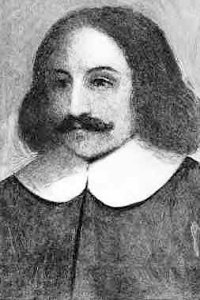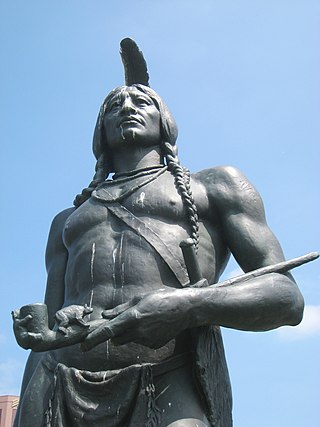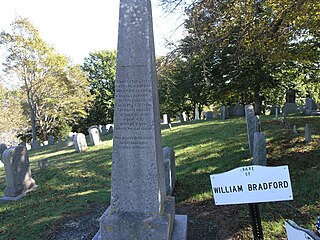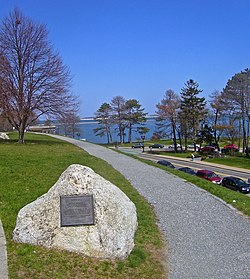
John Alden was a crew member on the historic 1620 voyage of the Mayflower which brought the English settlers commonly known as Pilgrims to Plymouth Colony in present-day Massachusetts, US. He was hired in Southampton, England, as the ship's cooper, responsible for maintaining the ship's barrels. Although he was a member of the ship's crew and not a settler, Alden decided to remain in Plymouth Colony when the Mayflower returned to England. He was a signatory to the Mayflower Compact.

Myles Standish was an English military officer and colonist. He was hired as military adviser for Plymouth Colony in present-day Massachusetts, United States by the Pilgrims. Standish accompanied the Pilgrims on the ship Mayflower and played a leading role in the administration and defense of Plymouth Colony from its foundation in 1620. On February 17, 1621, the Plymouth Colony militia elected him as its first commander and continued to re-elect him to that position for the remainder of his life. Standish served at various times as an agent of Plymouth Colony on a return trip to England, as assistant governor of the colony, and as its treasurer.

Plymouth Colony was, from 1620 to 1691, the first permanent English colony in New England and the second permanent English colony in North America, after the Jamestown Colony. It was first settled by the passengers on the Mayflower, at a location that had previously been surveyed and named by Captain John Smith. The settlement served as the capital of the colony and developed as the town of Plymouth, Massachusetts. At its height, Plymouth Colony occupied most of the southeastern portion of Massachusetts. Many of the people and events surrounding Plymouth Colony have become part of American folklore, including the American tradition of Thanksgiving and the monument of Plymouth Rock.

William Bradford was an English Puritan Separatist originally from the West Riding of Yorkshire in Northern England. He moved to Leiden in Holland in order to escape persecution from King James I of England, and then emigrated to the Plymouth Colony on the Mayflower in 1620. He was a signatory to the Mayflower Compact and went on to serve as Governor of the Plymouth Colony intermittently for about 30 years between 1621 and 1657. He served as a commissioner of the United Colonies of New England on multiple occasions and served twice as president. His journal Of Plymouth Plantation covered the years from 1620 to 1646 in Plymouth.

Plymouth is a town in Plymouth County, Massachusetts, United States. Located in Greater Boston, the town holds a place of great prominence in American history, folklore, and culture, and is known as "America's Hometown". Plymouth was the site of the colony founded in 1620 by the Mayflower Pilgrims, where New England was first established. It is the oldest municipality in New England and one of the oldest in the United States. The town has served as the location of several prominent events, one of the more notable being the First Thanksgiving feast. Plymouth served as the capital of Plymouth Colony from its founding in 1620 until the colony's merger with the Massachusetts Bay Colony in 1691. The English explorer John Smith named the area Plymouth and the region 'New England' during his voyage of 1614. It was a later coincidence that, after an aborted attempt to make the 1620 trans-Atlantic crossing from Southampton, the Mayflower finally set sail for America from Plymouth, England.

John Carver was one of the Pilgrims who braved the Mayflower voyage in 1620 which resulted in the creation of Plymouth Colony in America. He is credited with writing the Mayflower Compact and was its first signer, and he was also the first governor of Plymouth Colony.

Massasoit Sachem or Ousamequin was the sachem or leader of the Wampanoag confederacy. Massasoit means Great Sachem. Massasoit was not actually his name but a title. English colonists mistook Massasoit as his name and it stuck.

Plymouth Rock is the traditional site of disembarkation of the Mayflower Pilgrims who founded Plymouth Colony in December 1620. The Pilgrims did not refer to Plymouth Rock in any of their writings; the first known written reference to the rock dates to 1715 when it was described in the town boundary records as "a great rock." The first documented claim that Plymouth Rock was the landing place of the Pilgrims was made by 94-year-old Thomas Faunce in 1741, 121 years after the Pilgrims arrived in Plymouth.

Edward Winslow was a Separatist and New England political leader who traveled on the Mayflower in 1620. He was one of several senior leaders on the ship and also later at Plymouth Colony. Both Edward Winslow and his brother, Gilbert Winslow signed the Mayflower Compact. In Plymouth he served in a number of governmental positions such as assistant governor, three times was governor and also was the colony's agent in London. In early 1621 he had been one of several key leaders on whom Governor Bradford depended after the death of John Carver. He was the author of several important pamphlets, including Good Newes from New England and co-wrote with William Bradford the historic Mourt's Relation, which ends with an account of the First Thanksgiving and the abundance of the New World. In 1655 he died of fever while on an English naval expedition in the Caribbean against the Spanish.

Degory Priest was a member of the Leiden contingent on the historic 1620 voyage of the ship Mayflower. He was a hat maker from London who married Sarah, sister of Pilgrim Isaac Allerton in Leiden. He was a signatory to the Mayflower Compact in November 1620 and died less than two months later.

Christopher Martin and his family embarked on the historic 1620 voyage of the Pilgrim ship Mayflower on its journey to the New World. He was initially the governor of passengers on the ship Speedwell until that ship was found to be unseaworthy, and later on the Mayflower, until replaced by John Carver. He was a signatory to the Mayflower Compact. He and his family all perished in the first winter at Plymouth Colony.
Robert Cushman (1577–1625) was an important leader and organiser of the Mayflower voyage in 1620, serving as Chief Agent in London for the Leiden Separatist contingent from 1617 to 1620 and later for Plymouth Colony until his death in 1625 in England. His historically famous booklet titled 'Cry of a Stone' was written about 1619 and finally published in 1642, many years after his death in 1625. The work is an important pre-sailing Pilgrim account of the Leiden group's religious lives.
John Howland accompanied the English Separatists and other passengers when they left England on the Mayflower to settle in Plymouth Colony. He was an indentured servant and in later years an executive assistant and personal secretary to Governor John Carver.

Thomas Tinker and his family, comprising his wife and son, came in 1620 as English Separatists from Holland on the historic voyage of the Pilgrim Ship Mayflower. He was a signatory to the Mayflower Compact but he and his family all perished in the winter of 1620/1621, described by Bradford as having died in "the first sickness."
Plymouth Harbor is a harbor located in Plymouth, a town in the South Shore region of the U.S. state of Massachusetts. It is part of the larger Plymouth Bay. Historically, Plymouth Harbor was the site of anchorage of the Mayflower where the Plymouth Colony pilgrims disembarked in 1620 to establish a permanent settlement at Plymouth.

Burial Hill is a historic cemetery or burying ground on School Street in Plymouth, Massachusetts. Established in the 17th century, it is the burial site of several Pilgrims, the founding settlers of Plymouth Colony. It was listed on the National Register of Historic Places in 2013.

First Parish Church in Plymouth is a historic Unitarian Universalist church at the base of Burial Hill on the town square off Leyden Street in Plymouth, Massachusetts. The congregation was founded in 1620 by the Pilgrims in Plymouth. The current building was constructed in 1899.

Leyden Street, is a street in Plymouth, Massachusetts that was created in 1620 by the Pilgrims, and claims to be the oldest continuously inhabited street in the Thirteen Colonies of British North America.





















